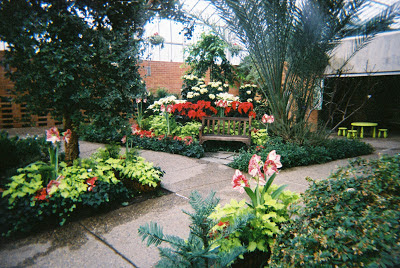It's not too often that I come across a classic Nikon film camera that I have not already tried out, and rarer still that I find one that I have never seen before.Yesterday, I was in Huron Camera in Dexter to drop off some film, and to have breakfast at Joe and Rosie's with my buddy Marc. I was looking in their dsiplay cases where the Nikon items are kept, and saw a lens that interested me -- a 100mm Vivitar, Non-AI lens. Not having a non-AI camera with me to try it on, I asked if it could be attached to one of the Nikkormats in the case. Cheryl handed me a slightly beat-up Nikkormat, and I was momentarily confused, as it was lacking the metering prong that would allow the lens to couple to the meter. It was a Nikkormat FS, an "economy" model that lacks the meter and mirror lock-up that is found on all other Nikkormats. A contemporary of the Nikkormat FT, it was produced from 1965-71. Since it has no meter, it lacks a battery, as well as the dials and display of the FT and FTN. It also weighs a bit less. In other words, it's not too different from a plain-prism Nikon F. Because it lacks a battery, it is truly a bare-bones, fully manual camera. When I have a camera with a non-functional meter, I am always thinking that I wish it were working so that I could use it. With the Nikkormat FS, that is not the case. Of course, having a separate light meter is helpful, and I have one when I am shooting my medium-format cameras. Of course, since I had never seen an FS before, I bought it for $39.

Once I got the Nikkormat FS home, I put on a slightly banged-up early version of the 50mm f/2 Nikkor-S lens that has the focal length marked as 5cm and the distance scale in feet. It is one of the best lenses ever made, and was in production for years. Later in the afternoon, I took it into town as the sun was low in the sky, and shot a roll of Kodak T-Max 100 that expired in 1999. "Metering" was by my seat of the pants. Every shot on the roll was acceptable, which must mean that my
sunny-16 intuition is pretty good when I decide to use it.
With all of the digital stuff that is being produced today, we take it for granted that any image is usually going to be properly exposed and in focus. The Nikkormat FS gets one back to the basics of photography, and in that, figuring out the light on one's own becomes a necessity. That sort of ties in with the "
slow photography" movement that has become a news-worthy item. For many of us, we have always been into "slow photography" we just thought that it was the way it was done.
You don't have to own a Nikkormat FS to go meterless -- there are thousands of cameras that never had meters. However, it would be hard to find one with a better lens than that 50mm f/2 Nikkor lens. If you want to go 35mm meterless, look at an Argus C-4 (the most usable Argus made), a Kodak Pony, a plain prism Nikon F, some of the Minolta SR-series SLRs, Pentax S2, a Zorki rangefinder, and for the cream of the crop, any thread-mount Leica.
































